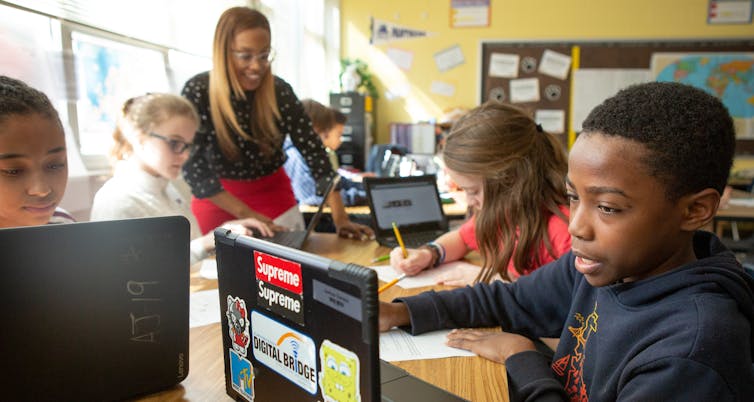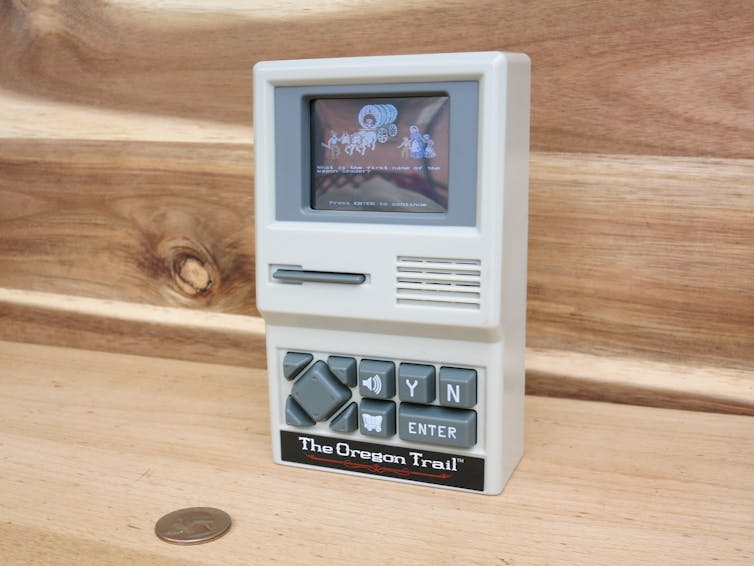Video gaming can bolster classroom learning, but not without teacher support
One highlight of my Grade 3 life was dying from dysentery at the hands of a video game. I was ahead on schoolwork, and allowed to use the classroom computer to pioneer a family across America in the game The Oregon Trail

Estimated reading time: 12 minutes
Scott DeJong, Concordia University
It was odd that I played this in a Canadian school — rather than exploring something like the challenges of long-haul trucking in the game Crosscountry Canada.
But with players still joking about Oregon Trail memes today, it’s clear the game made its mark.
When we look at educational video games, many struggle to make a similar impact. The reason is a mix of challenges for teachers and difficulties in game design.

Educational gaming market
Educational games are a big industry, pulling in an US$11.24 billion market in the United States.
While Canada’s market is a bit smaller (the overall video game market contributes 5.5 billion to our GDP), educational games and companies continue to pop up. Now after a pandemic boom in industry growth, we can expect more educational games to appear in classrooms.
But more doesn’t mean better.
While the number of educational games available is growing, according to a 2019 report by Common Sense Media, “the gap between the edtech products teachers use and what they say is effective is real and cuts across subjects.”
The change in landscape
From earliest days, games for learning were typically small endeavours built from passion or interest, like Grade 4 teacher Mabel Addis’s 1960s creation of one of the first-ever video games to teach economics to her students.
Early games like The Oregon Trail and Crosscountry Canada were products of the time when designers and technology were exploring what was possible. The newness of games garnered attention in and out of the classroom. However, as the industry grew, educational initiatives struggled to keep up.
Games like Fortnite boast player bases above 80 million and possess graphics, gameplay and budgets that no educational game can rival.
Hands-on experiential learning
Leaving the classroom can be a challenging task for school communities, but video games offer children hands-on moments for experiential learning. However, games will never have perfect representation and the extent to which they align with curricular goals will vary.
But commercial or educational games can offer immersive, powerful tools for learning. Many parents will be familiar with Minecraft, which has solidified its place in schools with an education edition of the game.
Or they may be familiar with Assassin’s Creed, which has attempted to recreate historical moments that put students into a particular time (albeit with some valid critiques on the realism of the game, and how representation may limit critical perspectives of dominant ideologies).
Such critiques point to the value of these and other games having a trained facilitator — like a teacher — to guide the player in their learning.
Teachers and gaming
Without an educator to critically engage students about moments designed in the game, or correct and challenge any inaccuracies, the learning can be misinformed or lost.
Yet, there is a need to make sure teachers know how to implement the game and ask questions around it.
Despite more and more parents playing games with their kids, school systems are slow to adapt to the agency-focused learning inspired by games. Teacher education and professional development needs to adjust.
Putting games in the classroom doesn’t require mastery. It requires teachers’ ability to connect the game to curricula and students’ lives.
Teaching students or killing time?
When facilitating games, a teacher should be able to discuss the games students play at home, identify where a student is interested and struggling in a game, draw connections to the themes in the story, and recognize how students are asked to play (what you click on, how you move).
All of this can produce powerful moments of reflection that can be tied to learning goals.
Good facilitation weaves the lesson and game together for reflection before, during and after play. But currently, in many cases, games are used like other time killers such as worksheets or drills.
A needed change in design
Most educational games are designed to be the teacher rather than working with them, which is why so many focus on storytelling.
Yet successful and popular games are all about choice. Games like Fortnite, Roblox or Minecraft tout some of the largest player bases among kids and offer a lot of agency to make decisions that directly impact their play.
Similar to playing in a sandbox, these games provide a space for players to determine what to build, where to go, what things to use and which to ignore. They have meaningful choice, and choice is engaging.
But this agency is concerning when your product is supposed to have someone understand “X concept,” and this leads some developers to make the game as an instructor.
This is why so many educational games are reduced to multiple choice stories, worksheet questions with a “funny” reward, or arguably not educational at all.
Beyond simple instruction
Educational games suffer because both the game and teacher want to be the instructor.
However, some developers and organizations are trying to improve the world of learning games. Organizations like Games for Change have some games in their collection that can go beyond simple models of instruction.
Field Day Lab offers interesting products designed alongside teachers. Montréal-based company Ululab attempts to connect the desires of teachers with the abilities of prominent game designers.
But for gaming to genuinely be part of learning, we need to help teachers effectively integrate the barrage of educational games into their classrooms.
Serious intervention needed
Some larger commercial game companies are jumping into this process (while making market inroads with young users). Dungeons and Dragons recently released teaching resources.
But anecdotally, I know passionate teachers have been doing this on their own.
When done well, games offer powerful moments for students, like my pixelated death in Grade 3. We can understand games as serious tools for grounding knowledge — and serious tools require serious intervention in both design, and in learning how to facilitate them.![]()
Scott DeJong, PhD Candidate and Research Assistant, Communication Studies, Concordia University
This article is republished from The Conversation under a Creative Commons license. Read the original article.
What's Your Reaction?
























